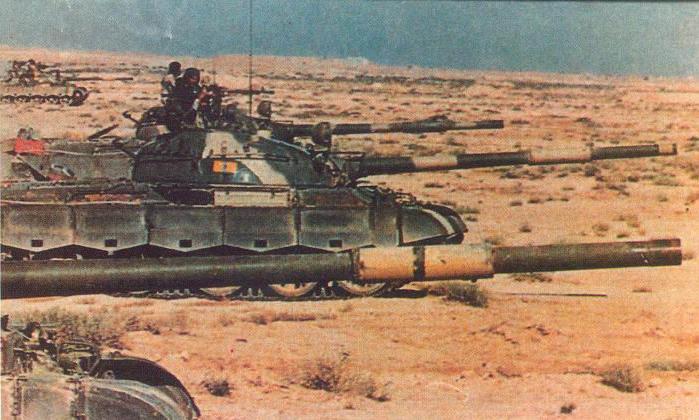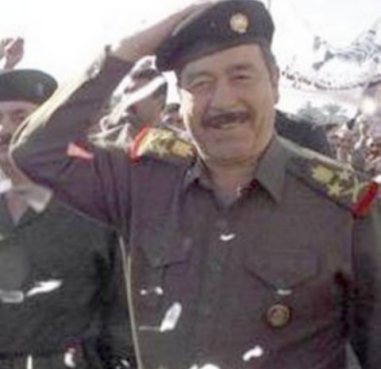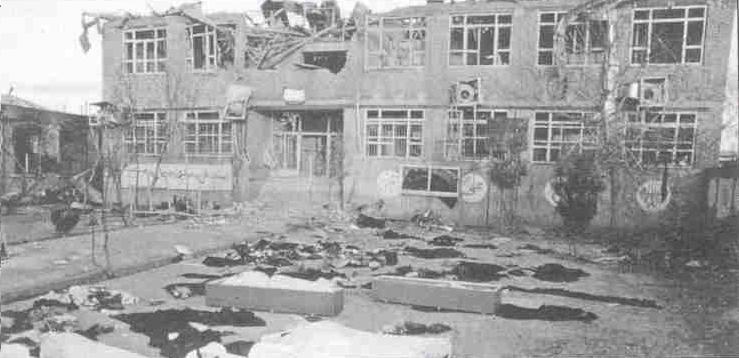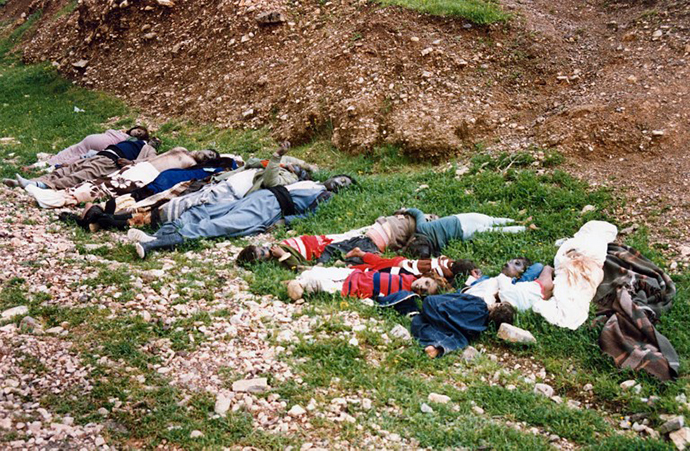The report below “US gave Saddam blessing to use toxins against Iranians” was published by RT News on August 26, 2013. Kindly note that (excepting the three pictures by RT News) the pictures and captions inserted in the article below were not published in the original Reuters release.
Readers are also encouraged to consult the following article:
=================================================================
As Washington ponders over whether to hammer Damascus over unidentified use of toxic agents in Syria, declassified CIA documents reveal that 25 years ago the US actually indulged ruthless Saddam Hussein to use chemical warfare gases in war with Iran.
 Saddam in his office with the uniform he often wore during his 1980s war against Iran (Photo: RT News).
Saddam in his office with the uniform he often wore during his 1980s war against Iran (Photo: RT News).
The recently declassified documents at the National Archives in College Park, Maryland, suggest that the US was closely following the use of chemical weapons by the Saddam Hussein’s regime both against the enemy in the Iran-Iraq War (1980-1988) and against Iraq’s Kurdish population, reports Foreign Policy magazine.
Despite the fact that the US establishment regarded Saddam Hussein as ‘anathema’ and his officials as ‘thugs’, the policies of President Ronald Reagan’s administration through 1980s was to ensure that Iraq would win the war with Iran, the FP stated.
 Pan-Arabism and Persophobia graduate from hate literature to violence: T-62 tanks of the Iraqi 6th Armored Division crossing the border into Iran on 1400hrs September 22, 1980. Saddam Hussein and the Baath party were convinced that as their tanks rolled into Khuzestan, they would be greeted as liberators by the Iranian Arabs. This may partly explain why the Iraqis may have miscalculated in the first few days of their invasion of Khuzestan province by not allowing more infantry to accompany their rapid-moving armor (see Iran at War: 1500-1988, 2001, pp.344-355). Instead of being hailed as liberators, Saddam Hussein’s forces were greeted with bitter opposition by the Iranian Arabs whose dogged resistance assisted the overall Iranian effort at slowing down the Iraqi advance (Photo: www.Acig.org).
Pan-Arabism and Persophobia graduate from hate literature to violence: T-62 tanks of the Iraqi 6th Armored Division crossing the border into Iran on 1400hrs September 22, 1980. Saddam Hussein and the Baath party were convinced that as their tanks rolled into Khuzestan, they would be greeted as liberators by the Iranian Arabs. This may partly explain why the Iraqis may have miscalculated in the first few days of their invasion of Khuzestan province by not allowing more infantry to accompany their rapid-moving armor (see Iran at War: 1500-1988, 2001, pp.344-355). Instead of being hailed as liberators, Saddam Hussein’s forces were greeted with bitter opposition by the Iranian Arabs whose dogged resistance assisted the overall Iranian effort at slowing down the Iraqi advance (Photo: www.Acig.org).
Former CIA official retired Air Force Colonel Rick Francona has said exclusively to Foreign Policy that starting from 1983 the US had no doubts that Hussein’s Iraq was using prohibited chemical weapons (mustard gas) against its adversary, while Iran lacked solid proof and could not bring the case to the UN.
Experienced Arabic linguist Rick Francona, who worked for both the National Security Agency (NSA) and the Defense Intelligence Agency (DIA), shared that the first time he had proof of Iraq using toxins against Iranians was in 1984, while he was serving as the US Air attaché in Amman, Jordan. He had solid proof that Iraqis had used Tabun nerve agent (GA) against Iranian troops advancing in southern Iraq.
 A handout picture dates March 16, 1988 and released by the Iranian official news agency IRNA shows two Kurdish children killed by an Iraqi chemical attack on the Kurdish city of Halabja in northeastern Iraq (Photo: RT News).
A handout picture dates March 16, 1988 and released by the Iranian official news agency IRNA shows two Kurdish children killed by an Iraqi chemical attack on the Kurdish city of Halabja in northeastern Iraq (Photo: RT News).
It has also been revealed that Saddam Hussein’s military industrial complex could not produce shells with toxic chemical substances itself and was heavily dependent on foreign equipment, with Italy been mentioned as one of the sources for the special equipment.
The enemy of my enemy is my friend – and then my enemy. Video of Donald Rumsfeld (Special envy of President Ronald Reagan) shaking hands with President Saddam Hussein on December 20, 1983 (see also report by Norm Dixon: How Reagan Armed Saddam with Chemical Weapons). Rumsfeld was then to be one of the most vociferous advocates of removing Saddam by force in 2003.
But Reagan’s administration was willing Baghdad to win the war, so it turned a blind eye on Iraq using lethal nerve agents against Iran, since that could turn the tide of war into a right direction, Foreign Policy reports.
The 1925 Geneva Protocol banned chemical warfare, while the Chemical Weapons Convention banning production and use of chemical arms was introduced in 1997. Iraq never bothered to sign the document, while the US did so in 1975, and by 1980s the US had international obligations to prevent the use of chemical weapons.
 Chemical Ali (Al Majid), one of the chief architects of the Baathist regime’s chemical weapons programs. Eric margolis has noted of the role of Western nations in helping Saddam Hussein develop non-conventional weapons. For more click here…
Chemical Ali (Al Majid), one of the chief architects of the Baathist regime’s chemical weapons programs. Eric margolis has noted of the role of Western nations in helping Saddam Hussein develop non-conventional weapons. For more click here…
During the war with its neighbor, Iran was in a state of heavy international isolation that followed the 1979 Islamic Revolution, and Iran’s military was lagging behind if compared to Iraqi Army.
Still, with the population fanatically supporting the Islamic leadership, Iran used inhumane tactics of ‘human wave’ attacks, turning its soldiers into expendables and thus nullifying Iraq’s military superiority.
In 1987, US satellite intelligence suggested that Iran was concentrating troops for a powerful offensive on Iraq’s southern Fao Peninsula in the direction of the key city of Basrah. The US believed that in spring of 1988 the Iranians might undertake a decisive attack, capitalizing on tactical mistakes by the Iraqi military which could result in Iraq’s defeat. According to Francona, after acknowledging with the intelligence data, President Ronald Reagan wrote a margin for the US Secretary of Defense Frank C. Carlucci: “An Iranian victory is unacceptable.” Thus, the Americans opted to share intelligence information with Baghdad, authorizing the DIA to give detailed data on exact locations of all Iranian combat units, Air Force movements, air defense systems and key logistics facilities. Rick Francona described the satellite imagery and electronic intelligence provided as “targeting packages” enabling the Iraqi Air Force to destroy Iranian targets. In 1988, Iraq conducted four highly successful chemical attacks on Iranian troops with sarin nerve agent, killing hundreds, if not thousands on the spot. The attacks precluded heavy artillery assaults and were disguised, being accompanied with use of smoke shells. Official Iranian statistics of the dead in these attacks is still unavailable. At the time Francona was serving as the US military attaché in Baghdad and he witnessed the aftermath of the attacks himself. He visited the Fao Peninsula shortly after it had been captured by the Iraqis. On the battlefield he saw hundreds of spent syringes with atropine, which Iraqi troops had been using as antidote to sarin’s lethal effects. Francona took several of these injectors to Baghdad as proof of chemical weapons use. Francona told Foreign Policy that Washington was “very pleased” with the Iranians being stricken preemptively to prevent them from launching their offensive. Also, in March 1988, Iraq launched a nerve gas attack on separatist Kurdish village of Halabja, some 240km northeast of Baghdad, killing 5,000, while 7,000 more suffered long-lasting health problems. WARNING-GRAPHIC PHOTO –
WARNING-GRAPHIC PHOTO –
 The result of an Iraqi air raid against a children’s school in Mianeh, Azarbaijan (northwest Iran) in 1988, killing more than 60 children and teachers. This horrific event was ignored by the Western press which was pro Saddam Hussein at the time (Picture source: Cooper, T. & Bishop, F. (2004). Iranian F-14 Tomcat Units in Combat. Oxford: Osprey Publishing).
The result of an Iraqi air raid against a children’s school in Mianeh, Azarbaijan (northwest Iran) in 1988, killing more than 60 children and teachers. This horrific event was ignored by the Western press which was pro Saddam Hussein at the time (Picture source: Cooper, T. & Bishop, F. (2004). Iranian F-14 Tomcat Units in Combat. Oxford: Osprey Publishing). [Click photo to Enlarge] An Iraqi T-55 training with an advanced British-manufactured tank gunnery simulator in 1987. Iraq’s armored corps had undergone a massive training and rearmament program by 1987-1988 – thanks to the the assistance of the Soviet Union and the Eastern Bloc, Egypt, India, Pakistan, England and numbers of Western countries (Picture Source: Armed Forces journal, July 1987 , p. 354; see also Farrokh, Iran at War, 2011, pp.400-402). British military personnel also refurbished and re-activated captured Iranian Chieftains for Saddam Hussein’s forces. For more on the role of England in supporting Saddam Hussein’s military machine, click here…
[Click photo to Enlarge] An Iraqi T-55 training with an advanced British-manufactured tank gunnery simulator in 1987. Iraq’s armored corps had undergone a massive training and rearmament program by 1987-1988 – thanks to the the assistance of the Soviet Union and the Eastern Bloc, Egypt, India, Pakistan, England and numbers of Western countries (Picture Source: Armed Forces journal, July 1987 , p. 354; see also Farrokh, Iran at War, 2011, pp.400-402). British military personnel also refurbished and re-activated captured Iranian Chieftains for Saddam Hussein’s forces. For more on the role of England in supporting Saddam Hussein’s military machine, click here… A handout file picture dated March 16, 1988 and released by the Iranian official news agency IRNA shows Kurdish adults and children lying dead following an Iraqi chemical attack on the Kurdish city of Halabja in northeastern Iraq (Photo: RT News).
A handout file picture dated March 16, 1988 and released by the Iranian official news agency IRNA shows Kurdish adults and children lying dead following an Iraqi chemical attack on the Kurdish city of Halabja in northeastern Iraq (Photo: RT News). Iranian victims of Saddam Hussein’s chemical warfare during the Iran-Iraq war of 1980-1988. The above photo is from some of the victims of Iraqi warplanes that dropped mustard gas bombs on the Iranian town of Sardasht on June 28, 1987. Official reports of this attack cite nine thousand people exposed and 130 dead. As reported by The Los Angeles Times: “They [Iranian civilians] dropped dead on the cobbled streets of the town center. They cried out as their eyes burned and skin bubbled.” Despite the rapacity of these actions, Western Press-media outlets, (the majority of) Human Rights Organizations, and Politicians continued to support Saddam right up to his Kuwait invasion in August 2-4, 1990 (Photo forwarded to Kavehfarrokh.com on August 26, 2013).
Iranian victims of Saddam Hussein’s chemical warfare during the Iran-Iraq war of 1980-1988. The above photo is from some of the victims of Iraqi warplanes that dropped mustard gas bombs on the Iranian town of Sardasht on June 28, 1987. Official reports of this attack cite nine thousand people exposed and 130 dead. As reported by The Los Angeles Times: “They [Iranian civilians] dropped dead on the cobbled streets of the town center. They cried out as their eyes burned and skin bubbled.” Despite the rapacity of these actions, Western Press-media outlets, (the majority of) Human Rights Organizations, and Politicians continued to support Saddam right up to his Kuwait invasion in August 2-4, 1990 (Photo forwarded to Kavehfarrokh.com on August 26, 2013).



